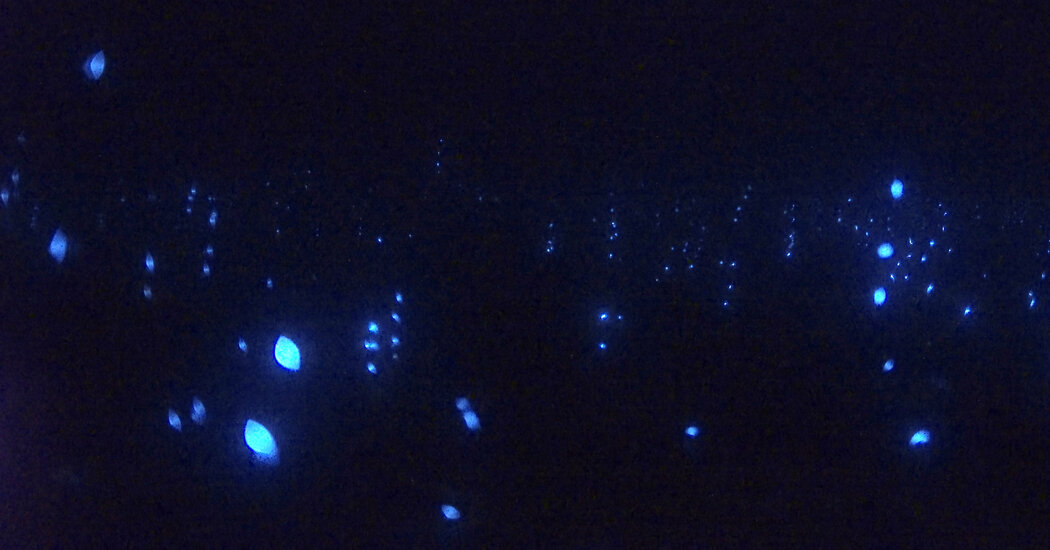In 2017, two evolutionary biologists diving off the coast of Panama made a startling discovery.
Evening was falling over the shallow waters of Bocas del Toro James Morina professor emeritus at Cornell College, clicked on his underwater flashlight to try the ocean ground.
In reply to this query, a whole bunch of tiny blue lights sparked to life, spreading out in waves.
“We have been each swearing on our branches in amazement,” he stated. Todd Oakleyprofessor on the College of California, Santa Barbara.
In paper published Wednesday within the Proceedings of the Royal Society B, scientists detailed the courtship rituals of a brand new species of “sea firefly” — a tiny crustacean no bigger than a grain of sand that places on a spectacular underwater present by sneezing glowing mucus.
However these usually are not easy flashes. Just like the synchronized mass shows of lightning bugs on land, the sunshine present of sea fireflies is a rigorously choreographed dance in tune with the rhythms of the evening sky.
“It is an underwater fireworks present — the very best Fourth of July I’ve ever seen,” he stated. Nicholas Hensleya postdoctoral fellow at Cornell College who research animal habits and led the brand new examine.
The creatures behind the unusual Panamanian gentle present are known as shellfish. Dr. Hensley compares tiny crustaceans and sesame seeds to eyeballs. Below a microscope, you’ll be able to see the shellfish’s shrimp-like physique coated in a clear shell.
A wierd organ known as the “higher lip” makes many shellfish bioluminescent. The higher lip shops two chemical substances that, when mixed, produce a vivid blue explosion.
“It is actually like a handlebar drinker of sunshine glowing immediately above their mouth,” Dr. Hensley stated.
Ostracods all around the world use their luminous mucus for a lot of functions, comparable to performing courtship shows or forcing predators to spit them again out (the mucus apparently tastes actually dangerous). However Dr Morin stated the ocean fireflies’ gentle show was “invigorating” on the evening he and Dr Oakley noticed them, and was orchestrated in a method that different species usually are not.
The group studied this mysterious group of sea fireflies, provisionally named EGD (which implies “grass entice”), and satisfied them to carry out gentle reveals in captivity. Now, researchers suppose they’ve pieced collectively the person steps of EGD’s courtship dance.
The romance begins at nautical twilight – the time between when the solar units and the moon has not but risen, and the ocean fireflies’ solely competitors for shine is starlight. Every male rises from the underside of the grass after which descends in a slim dive, sneezing between 4 and eight balls of sunshine as he goes. Scientists agreed that the consequence was astonishing, like a string of Christmas lights or a glowing pearl necklace.
The group discovered that EGD males are extremely suggestible. The primary male to provide glowing mucus triggers a series response as his neighbors observe swimsuit, creating ripples of sunshine. The farther a firefly is from its nearest competitor, the extra mucus pearls it produces – maybe as a result of it has a greater probability of attracting females if its rivals are out of its attain.
Though bioluminescence is frequent within the ocean, this type of coordinated group show is spectacular for a creature the scale of a sesame seed. Edith Ariesa bioluminescence professional and CEO of the Society for Ocean Analysis and Conservation, who was not concerned within the examine.
Dr. Weider praised Dr. Hensley’s examine as a result of it offered a “uncommon” perception into bioluminescent courtship, which typically happens past the attain of scientists. She stated the phenomenon is a hanging instance of convergent evolution, as each aquatic and terrestrial fireflies individually developed related shows, though the creatures’ final frequent ancestor lived about 500 million years in the past.
EGD’s gentle present is extra delicate than that of its winged cousins - the firefly has to surrender its place when it flashes its gentle, however the sea firefly can put a ways between itself and its belching gentle, Dr. Weider added. . It is like a glowing, coded map – females of this species know easy methods to “learn” the display screen to search out their snotty suitors, whereas predators are left to retrace their tracks.
Dr. Hensley stated he might solely marvel at how this wonderful dance might have occurred, unnoticed, but so near civilisation. Within the seagrass mattress of Bocas del Toro the place this species was found, the place the shellfish kind their underwater clusters within the hope of discovering love, you’ll be able to hear the wonderful bass from the dance membership proper on the seaside.

